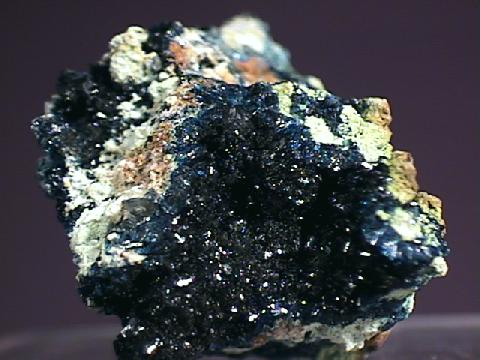
CLINOCLASE
Specimen cli-5
$ 65.00
Dims: 1.0" x 0.8" x 0.8" (2.5 x 2.0 x 2.0 cm)
Wt: 11.8 g
Majuba Hill Mine, Pershing County, Nevada, U.S.A.
Though the chalky, pale green host rock of this specimen is quite small, it is heavily permeated with blue veins of Clinoclase. A few of these veins open into pockets that are lined with tiny crystals. Though these crystals are too small to effectively study without magnification, they show no damage that I can see. Using a loupe, one can see that they have a visible monoclinic bladed form that is rather warped due to intergrowth. Their color is a deep navy-blue and they have a bright, pearly luster. I estimate that at least 50% of this piece's mass is made up of Clinoclase.
 Amethyst Galleries' Mineral Gallery MINERALS |
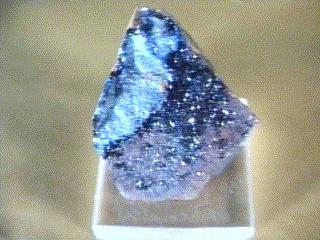
CLINOCLASE specimen cli-1
$ 30.00
$ 30.00
Dims: 1-1/4" x 1-1/4" x 1/4"
Wt: 20 g. w/ base
Majuba Hill, Pershing Co., Nevada, U.S.A.
A crust of dark blue Clinoclase covers about 1/3 of a face of the host rock on this lovely specimen. The crust likely formed in a crevice between the host rock and another base rock, with crusts forming on both surfaces and growing into each other, thus making it difficult to see crystal structure. However, the crust did not connect completely in some areas, so some of the dark blue needles are visible, if a little small. Given their blue color and the brown base rock, the needles seem to be the only instant way to discern this mineral from azurite. It's a pretty little specimen of an unusual mineral.

cli-1 ($ 30.00)
Majuba Hill, Pershing Co., Nevada, U.S.A.
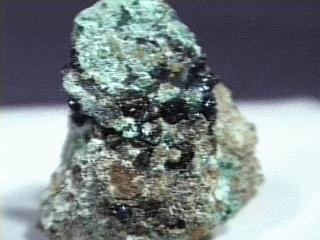
CLINOCLASE specimen cli-2
$ 45.00
$ 45.00
Dims: 1.88" x 1.88" x 1.25"(4.8 x 4.8 x 3.2 cm)
Wt: 2.07 oz.(58.7 g)
Majuba Hill Mine, Pershing County, Nevada, U.S.A.
A rather odd cluster of small Clinoclase crystals makes up this specimen. It occurs in the form of little dark blue spheroids that, though visible, are more easily seen with a loupe. When one does so, one can see that each spheroid is made up of tightly packed "books" of Clinoclase blades that show surprising curvature. These little blobs do not exceed 4 mm in diameter, and most of them line crevices and fissures in the rock. Just as I was writing this and examining the specimen, I found a small opening that I gently widened- it leads to a crevice that is at least 1/2"(1.3 cm) deep which contains at least 4 more spheroids of Clinoclase. The host rock seems to be made up largely of quartzite or a sandstone, and has quite a bit of chrysocolla/malachite/conichalcite spread over it. I really like this specimen because of the little crevices- they make me want to "explore".


cli-2 ($ 45.00)
Majuba Hill Mine, Pershing County, Nevada, U.S.A.
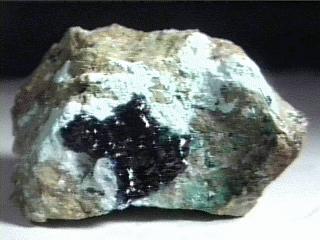
CLINOCLASE specimen cli-3
$ 37.50
$ 37.50
Dims: 2.13" x 1.63" x 1.2"(5.4 x 4.1 x 3 cm)
Wt: 2.06 oz.(58.4 g)
Majuba Hill Mine, Pershing County, Nevada, U.S.A.
The Clinoclase on this specimen occurs as a small crust made up of many interlocking crystals that are most easily seen with a loupe. They have a blue coloration that is so dark as to appear black except where breakage has occurred. Under 10x magnification, one can easily see the flat, bladed crystals which tend to grow parallel to the host rock, and can reach almost 1/4"(5 mm) in length. They have a pearly to vitreous luster and rest on a bed of decayed secondary copper ores-- likely chrysocolla, and maybe a bit of conichalcite. All of this in turn rests on a base of fine-grained quartzite that enfolds some considerably larger grains of smoky quartz.

cli-3 ($ 37.50)
Majuba Hill Mine, Pershing County, Nevada, U.S.A.
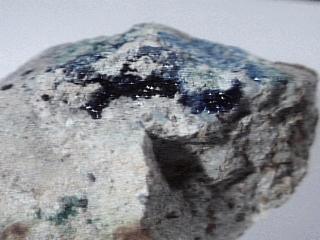
CLINOCLASE specimen cli-4
$ 30.00
$ 30.00
Dims: 4" x 3" x 2"(10.2 x 7.6 x 5.1 cm)
Wt: 13.9 oz.(395 g)
Majuba Hill Mine, Pershing County, Nevada, U.S.A.
This large specimen consists of a Clinoclase crust that covers part of a large quartzite host rock. Clinoclase crystals are visible at one edge of the crust, and have a very dark blue color that is difficult to see without internal fractures or some form of damage playing a part. The crystals are not larger than a few millimeters in length and have a vitreous luster. The crust extends to cover a small area(about 10%) of the host's surface.

cli-4 ($ 30.00)
Majuba Hill Mine, Pershing County, Nevada, U.S.A.

CLINOCLASE specimen cli-5
$ 65.00
$ 65.00
Dims: 1.0" x 0.8" x 0.8" (2.5 x 2.0 x 2.0 cm)
Wt: 11.8 g
Majuba Hill Mine, Pershing County, Nevada, U.S.A.
Though the chalky, pale green host rock of this specimen is quite small, it is heavily permeated with blue veins of Clinoclase. A few of these veins open into pockets that are lined with tiny crystals. Though these crystals are too small to effectively study without magnification, they show no damage that I can see. Using a loupe, one can see that they have a visible monoclinic bladed form that is rather warped due to intergrowth. Their color is a deep navy-blue and they have a bright, pearly luster. I estimate that at least 50% of this piece's mass is made up of Clinoclase.

cli-5 ($ 65.00)
Majuba Hill Mine, Pershing County, Nevada, U.S.A.

CLINOCLASE specimen cli-6
$ 30.00
$ 30.00
Dims: 2.5" x 1.6" x 1.4" (6.4 x 4.1 x 3.6 cm)
Wt: 3.57 oz. (101.2 g)
Majuba Hill Mine, Pershing County, Nevada, U.S.A.
A thin crust of Clinoclase covers one face of the rusty gray host rock of this specimen. This crust appears to have started out as a vein trapped in the host rock which was later broken apart. Though it does not appear as such upon first glance, almost all of the Clinoclase is crystalline in nature. One can clearly see its compact, radiating habit along the broken edges of the crust, and there is one area wherein tiny, bladed crystals can be seen. The Clinoclase has a dark blue color with a hint of gray or green in it, and possesses a bright vitreous luster where crystals are exposed. These crystals have such a deep blue coloration that, tiny as they are, they only show a dim translucence. There are a few smaller veins that grow off of the crust and into the host rock, but these are very small and stay close to the crust. The gray host rock appears to be made of a limestone.
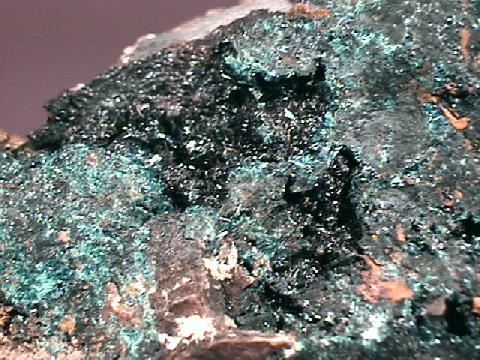

cli-6 ($ 30.00)
Majuba Hill Mine, Pershing County, Nevada, U.S.A.
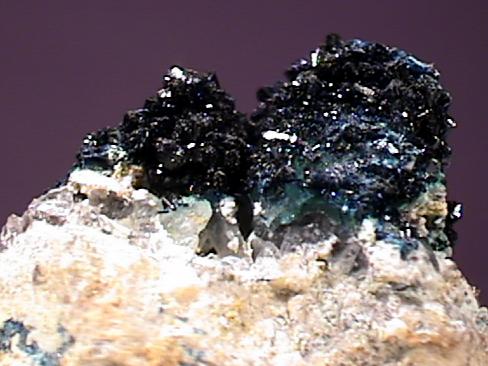
CLINOCLASE specimen cli-7
$ 30.00
$ 30.00
Dims: 1.1 x 0.7 x 0.4" (2.8 x 1.8 x 1.0 cm)
Wt: 13.9 g w/ specimen box
Majuba Hill Mine, Pershing County, Nevada, U.S.A.
This thumbnail specimen consists of a crust of tiny Clinoclase crystals that covers two large, undefined crystals which rest on a dull, tan-colored host rock. The Clinoclase bladess are in excellent condition, showing very little human-induced damage, and have good monoclinic form, though this is very difficult to determine without at least 10-power magnification. The blades have the standard deep navy-blue coloration and a bright, pearly-to-vitreous luster, and are essentially opaque due to their color depth and intergrowth. I cannot be certain, but I believe that these crystals form a crust coating two broken smoky quartz crystals. The breakage has exposed some surfaces that have a vitreous luster and a curved, conchoidal appearance, and seem to have a pale brown color and are possibly transparent. Unfortunately, all of the natural surfaces of these crystals are completely covered by the Clinoclase, so they are very difficult to study. The specimen is hot-glued to the inside of a cubic plastic specimen box.

cli-7 ($ 30.00)
Majuba Hill Mine, Pershing County, Nevada, U.S.A.
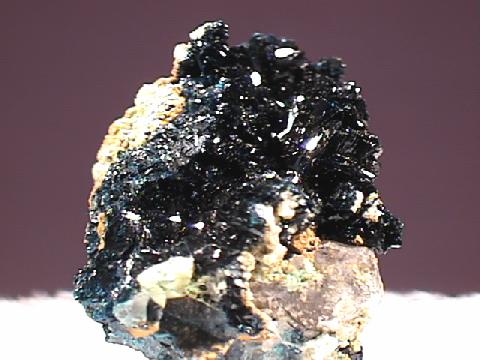
CLINOCLASE specimen cli-8
$ 36.00
$ 36.00
Dims: 0.7 x 0.6 x 0.5" (1.8 x 1.5 x 1.3 cm)
Wt: 12.3 g w/ specimen box
Majuba Hill Mine, Pershing County, Nevada, U.S.A.
Because of their intense intergrowth and the fact that they line a hollow, it is difficult to determine exactly how many Clinoclase crystals are present on this small thumbnail specimen- I believe that there are at least 15, and likely 20 or more. All appear to be in very good condition, as I see little fresh damage on the crust besides that on its edges. The Clinoclase crystals do not exceed 0.1" (3 mm) in any dimension and appear to have fairly good monoclinic form, even with their intense intergrowth. The visible edges are reasonably well-defined and the faces are somewhat curved but clean, and possess a vitreous luster. Their blue coloration is so deep that the crystals appear to be black and are essentially opaque. The specimen is glued into a plastic specimen box.

cli-8 ($ 36.00)
Majuba Hill Mine, Pershing County, Nevada, U.S.A.
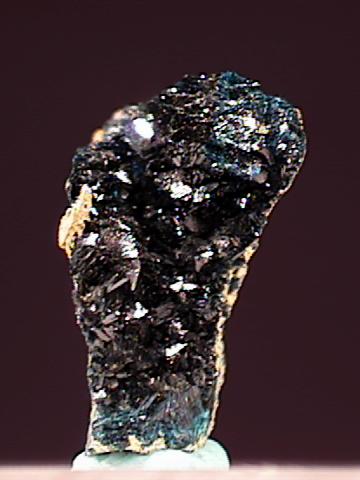
CLINOCLASE specimen cli-9
$ 55.00
$ 55.00
Dims: 0.7 x 0.5 x 0.3" (1.8 x 1.3 x 0.8 cm)
Wt: 2.4 g
Majuba Hill Mine, Pershing County, Nevada, U.S.A.
This small thumbnail specimen consists of a "druse" of heavily intergrown Clinoclase crystals that likely lined a crevice in a chalky beige host rock. Almost all of the host rock has since weathered away, leaving the crust. It is generally in good condition, as there is some visible damage to one area. Their intergrowth makes it difficult to determine, but none of the crystals appear to exceed 0.1" (3 mm) in any dimension. Though heavily intergrown, a few of the crystals show good, round monoclinic bladed form, with sharp edges and relatively clean, striated faces that possess a bright pearly luster. All have the dark, almost navy-blue color with a slight hint of green; this color is easiest to see at the point of damage, as the crystals are effectively opaque due to their depth of color.

cli-9 ($ 55.00)
Majuba Hill Mine, Pershing County, Nevada, U.S.A.

CLINOCLASE specimen cli-10
$ 30.00
$ 30.00
Dims: 3.0 x 2.5 x 1.6" (7.6 x 6.3 x 4.0 cm)
Wt: 6.1 oz. (173 g)
Myler Mine, Majuba Hill, Pershing County, Nevada, U.S.A.
A dusting of microscopic Clinoclase crystals partly covers the rusty host rock of this cabinet specimen. These crystals are so tiny and heavily intergrown that one can not study them effectively even with the help of a loupe. There is a patch of noticeable damage on the crust, but most of it appears to be in excellent condition. The crust has a lovely cobalt-blue coloration and a dull sparkle from the tiny crystals, which are too small for me to study either their monoclinic form or their conductivity of light. Other than hosting a few crusts of possible goethite, the base rock is nondescript.

cli-10 ($ 30.00)
Myler Mine, Majuba Hill, Pershing County, Nevada, U.S.A.
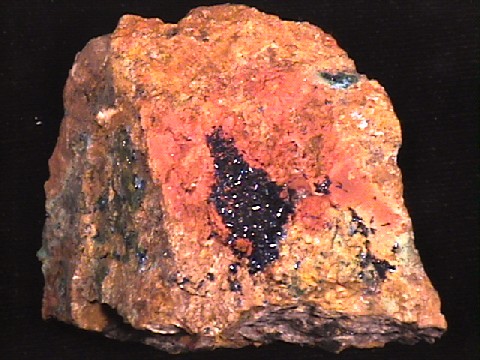
CLINOCLASE specimen cli-11
$ 75.00
$ 75.00
Dims: 1.93x1.69x0.94" (4.9x4.3x2.4cm)
Wt: 1.93oz. (54.6g)
Majuba Hill, Pershing County, Nevada, USA
THis specimen boasts a variety of excellent clinoclase crystals. The largest patch is the deepest and contains the largest crystals, some of which approach 1mm in length. They are transparent, highly lustrous, and are colored a perfect clinoclase deep blue. The patch is thick enough that it almost looks black. Another tiny cavity has a perfect radial puffball of clinoclase crystals. And on one side of the specimen, there are several flat radial sprays exposed to examination with a loupe. I especially like the tiny radial spray perched on a small patch of malachite.
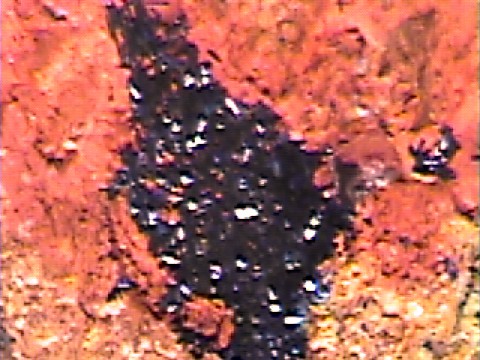

cli-11 ($ 75.00)
Majuba Hill, Pershing County, Nevada, USA
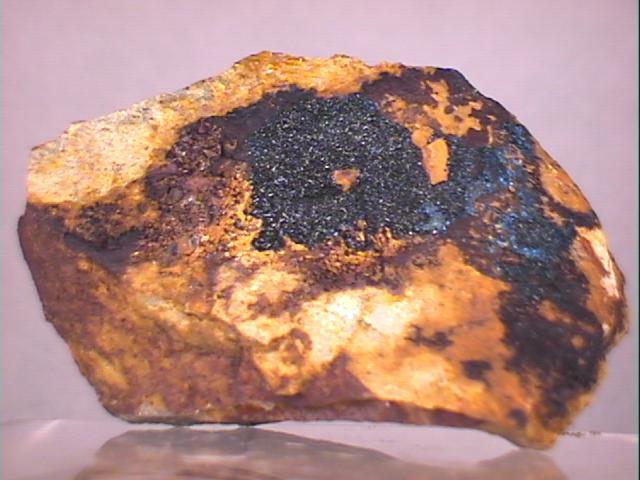
CLINOCLASE specimen cli-12
$ 25.00
$ 25.00
Dims: 3.28x2.04x1.29" (8.33x5.19x3.28cm)
Wt: 5.01oz (141.9g)
Majuba Hill, Pershing County, Nevada, USA
On a brown host rock, there is a patch of clinoclase crystals. The crystals are very tiny, and have a very deep aqua-blue color. Under a loupe, they appear at least translucent, although they may be transparent (they are too small for me to tell, even with a 15 power loupe). They are very sparkly, due to a vitreous luster . Around the edges of the patch, many of the crystals are damaged, with gives them a brighter color and enables better examination. Some of the crystals have a good prismatic structure, although they are too small for me to discern their cross section and termination.
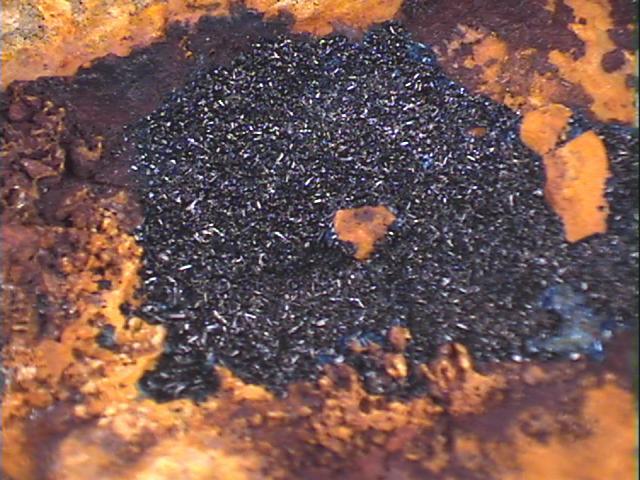

cli-12 ($ 25.00)
Majuba Hill, Pershing County, Nevada, USA

CLINOCLASE specimen cli-14
$ 225.00
$ 225.00
Dims: 1.28x0.92x0.74in (3.24x2.34x1.89cm)
Wt: 0.23oz (6.6g)
Majuba Hill, Pershing Country, Nevada, USA
This beautiful clinioclase specimen is a crust of lovely deep turquoise blue clinoclase crystals surrounding a cluster of black botryoidal terminations. It is obvious that the black is due to light entering the terminations of the individual crystals, which appear blue from the sides. The radial growth of the acicular crystals is apparent, as is their translucent (possibly transparent) nature. THe strong contrast of the bright turquoise blue edges with the nearly black interior is striking.


cli-14 ($225.00)
Majuba Hill, Pershing Country, Nevada, USA

CLINOCLASE specimen cli-13
$ 42.00
$ 42.00
dims mm=77.02x59.40x28.70
wt g=144.3
Copper Stope, Majuba Hill Mine, Pershing County, Nevada, USA
The specimen displays a number of copper minerals with colors ranging from pale blue to shades of green to deep turquoise blue. The latter color is from clinoclase, which also has the best crystals and dominates the specimen. The specimen does not have much sparkle, except under a loupe which reveals nearly black prismatic crystals in the middle of each tiny patch of pretty greenish-blue clinoclase. These crystals are tiny and appear black except when the light hits one just right, and then it becomes obvious that these are transparent crystals of clinoclase.


cli-13 ($ 42.00)
Copper Stope, Majuba Hill Mine, Pershing County, Nevada, USA